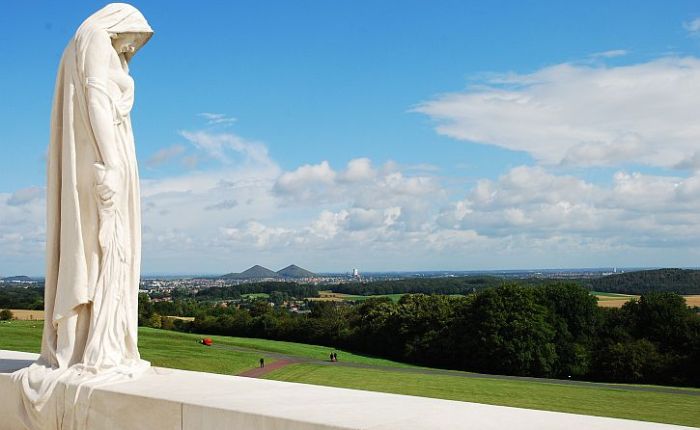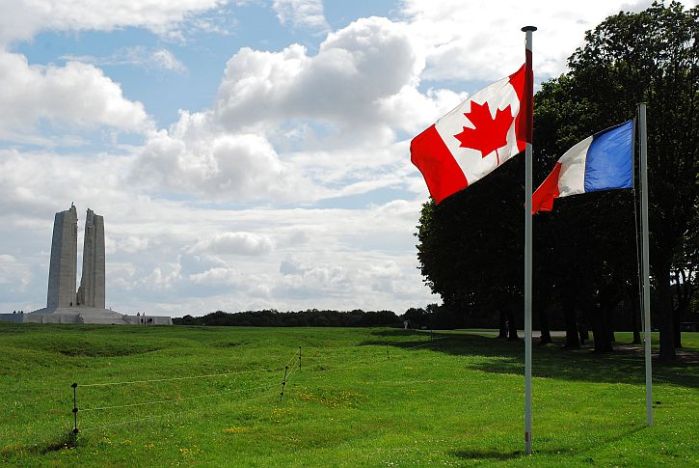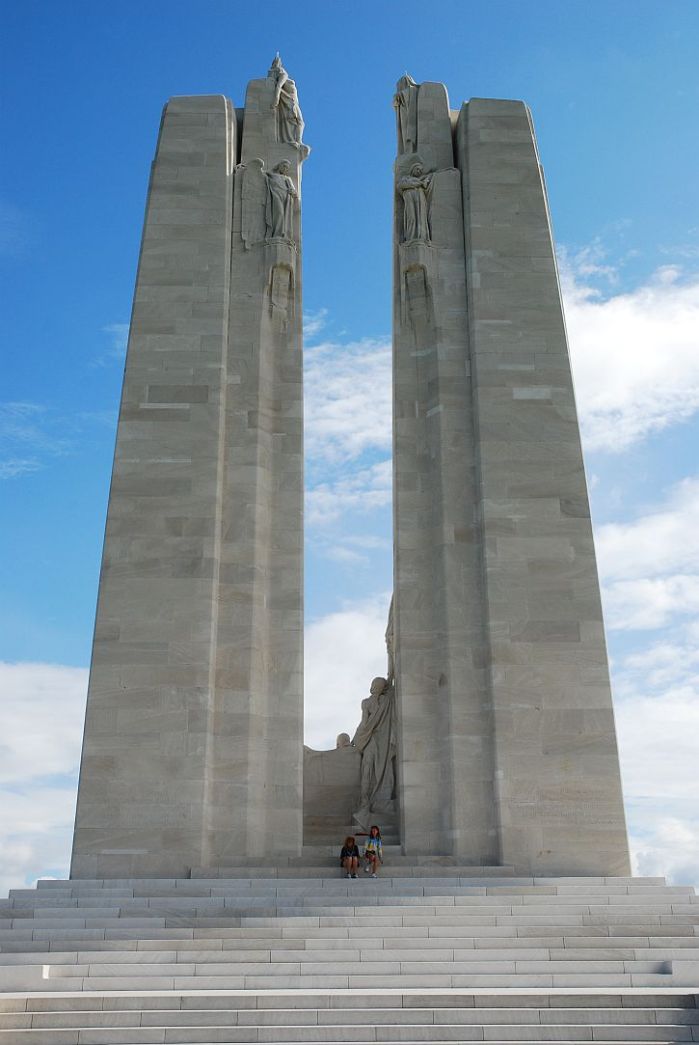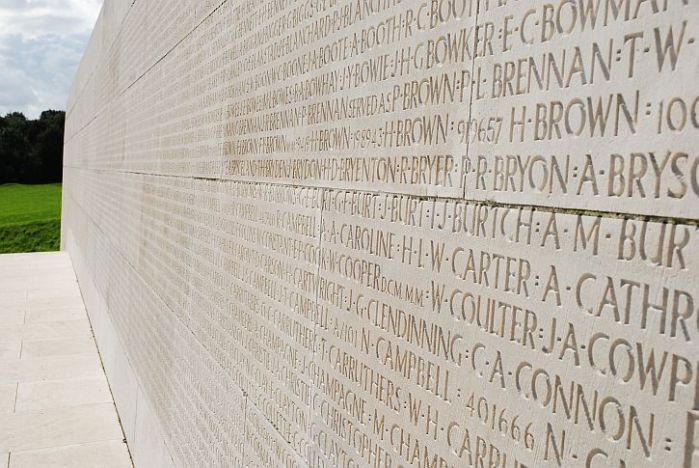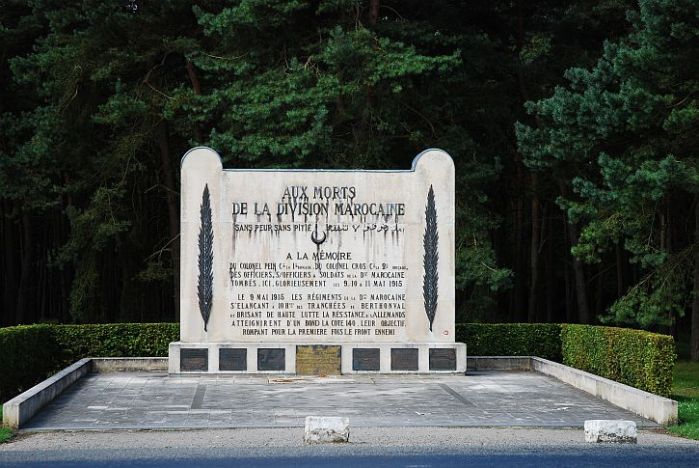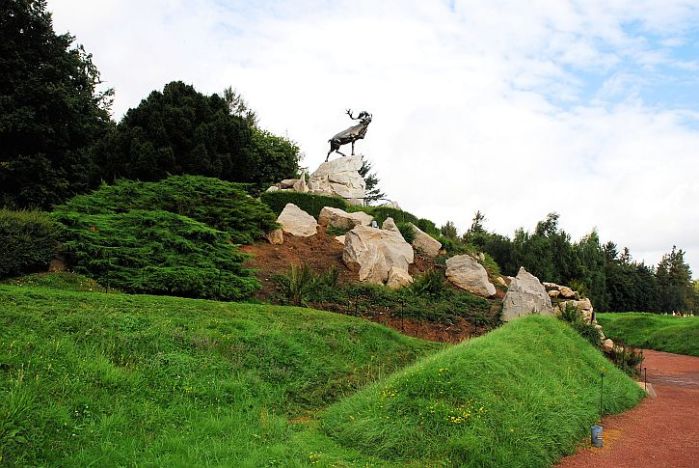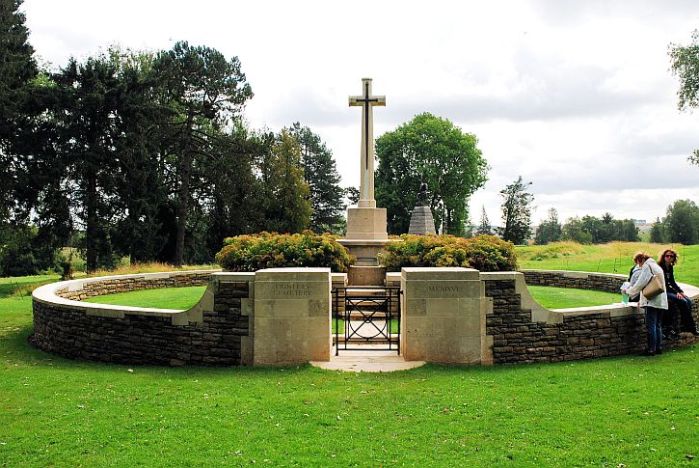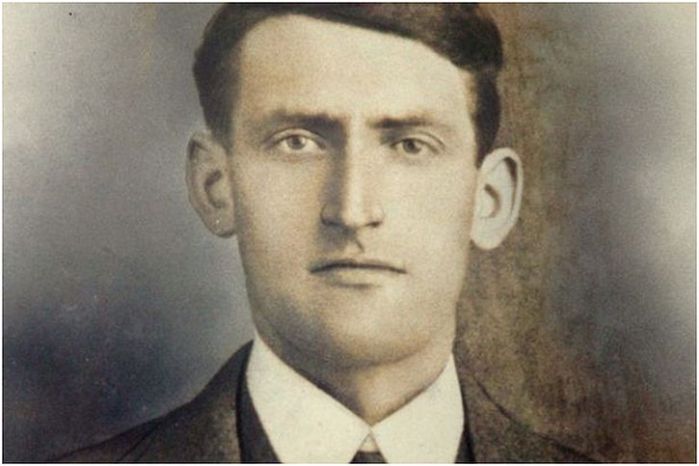The Canadian National Memorial at Vimy
Here dead we lie
Because we did not choose
To live and shame the land
From which we sprung.Life, to be sure,
Is nothing much to lose,
But young men think it is,
And we were young.– A E Housman
As I continued my odyssey along the Western Front, a theme began to emerge at the cemeteries and monuments I visited. My first port of call was the Canadian National Memorial at Vimy, a memorial to the 60,000 Canadians who were killed in battle during the the Great War. Alongside the famous pylon towers is another memorial to the North African soldiers who fell on Vimy Ridge. In the following days I would spend time at cemeteries and memorials which recalled the sacrifice of others who came, often from other continents, to fight in the European ‘civil war’: Canadians and Newfoundlanders, Australians, Scots, Irish, Welsh and men from the Indian sub-continent.
We’re not making a sacrifice. Jesus, you’ve seen this war. We are the sacrifice.
– Frank McGuinness, Observe the Sons of Ulster Marching Towards the Somme
The twin pylons of the Canadian National Memorial at Vimy
The Vimy Memorial is an awe-inspiring structure: you see its twin spires rising above the village of Vimy from miles away as you approach Vimy ridge across the flatlands of Picardy. The Memorial was designed by a sculptor from Toronto, Walter Seymour Allward, its two pylon towers to rising skywards to represent Canada and France, two countries united in their sacrifice to war.The Memorial bears the names of 11,168 missing Canadians, killed in action in France but whose remains have not been found or identified. The monument was located on the imposing ridge of high ground at Vimy Ridge, north of Arras, because this had been the scene of a successful attack by the Canadian Expeditionary Force in the spring of 1917, during the Battles of Arras.
The view from Vimy Ridge across the plain below
The Germans had secured the Ridge by October 1914, and remained in control of it despite French Army attempts to dislodge them twice in 1915 without success and at tremendous loss of over 100,000 casualties. In the Second Battle of Artois (May-June 1915) the French 1st Moroccan Division gained a foothold at Hill 145, but could not hold on to it. It was not until the spring of 1917 that the Canadians managed to secure the Ridge.
The mourning figure of ‘Canada Bereft’ at Vimy
The two pylons rise 120 feet (30 metres) from the base of the Memorial. Beneath them, arranged around a vast paved terrace, are twenty sculpted human figures. The terrace is dominated by ‘Canada Bereft’, a female figure draped in a cloak which stands alone on the wall, head bowed, looking down at a stone sarcophagus representing Canada’s war dead. The figure was carved from a single 30 tonne block of limestone. From this vantage point it is easy to see the advantage gained by the German troops as you look out across the plain towards Lens and the slag heaps at Loos-en-Gohelle that rise like volcanoes on the horizon.
The Vimy Memorial: The Chorus
The tops of the pylon are sculpted to form The Chorus – a group of eight figures representing Justice, Peace, Hope, Charity, Honour, Faith, Truth and Knowledge. Peace is the highest figure on the monument, reaching upwards with a torch. Between the pylons is The Spirit of Sacrifice, a group of two figures which comprises a dying soldier who has passed a torch to a comrade.
Vimy: one of The Mourning Parents figures
On the other side of the Memorial are two reclining figures, located on either side of the steps, representing the mourning mothers and fathers of Canada’s war dead.
The Names of the Missing Canadians
The names of more than 11,000 Canadians, with no known resting place in France, are inscribed on the walls around the base of the monument in a font specially designed by Allward.
The Moroccan memorial
At the entrance to the Vimy Memorial stands the reminder of soldiers from yet another continent who died here. The Memorial to the Moroccan Division recalls the bravery of a division that was composed of regiments of Zouaves (North African volunteers) and French Foreign Legion soldiers who seized the ridge in May 1916 but who were forced to retreat. On 9 May 1916, men of the 1st Moroccan Division managed to break through the German lines to begin the attack on Vimy Ridge. Unfortunately, white squares had been sown on their uniforms to help the French artillery adjust the range of their guns. Tragically, this made the men of the Moroccan Division visible not only to the French, but also to the Germans positioned on their flank. They became easy targets. As the French artillery ran out of ammunition, expected reinforcements failed to arrived. The order to retreat was given, and the position was lost.
French Zouaves – North African volunteers – in WW1
I know of only one poem of the First World War which recognises the contribution of soldiers from France’s African colonies. Five of the six sections in Guillaume Apollinaire’s 1918 volume of poems, Calligrammes, were composed while he was serving on the front line in the war. One section is entitled ‘The Sighs of the Gunner from Dakar’, in which, remarkably, Apollinaire adopts the voice of a soldier from Senegal. Apollinaire died in 1918, not in battle, but in the flu pandemic.
The Sighs of the Gunner from Dakar [Extract]
In the log dugout hidden by osiers
Near grey cannons turned toward the north
I dream of the African village
Where we danced where we sang and made love
And made long speeches
Noble and joyful
I see again my father who fought
The Ashantis
In the service of the English
I see again my sister with the crazy laugh
With breasts as hard as bombshells
And I see again
My mother the witch who alone in the village
Scorned salt
Crushing millet in a mortar
[…]
And I was a servant in Paris
I don’t know my age
But at the recruiting
They wrote down twenty years old
I’m a French soldier and so they turned me white
Sector 59 I can’t say where
But why is it better to be white than black
Why not dance and make speeches
Eat and then sleep
And we shoot at the Boche supplies
Or at the iron wires in front of the doughboys
Under the metallic storm
I remember a hideous lake
And couples chained by an atrocious love
A crazy night
A night of sorcery
Like tonight
Where so many horrible eyes
Explode in the brilliant sky
Near to Vimy is Ablain-Saint-Nazaire, the village featured in Henri Barbusse’s Under Fire, the book he dedicated to ‘the memory of the comrades who fell beside me at Croucy and on Hill 119’ (locations along the Vimy Ridge):
The village has disappeared. Never have I seen such a disappearance of a village. Ablain-Saint-Nazaire and Carency still preserved some semblance of locality, with their gutted and truncated houses and their courtyards filled with plaster and tiles. Here, framed by the shredded trees – which, in the midst of the fog, surround us with a ghostly sort of decor – nothing has any shape; there is not even a fragment of wall or railing or gate still standing, and we are amazed to discover, under the heap of beams, stones and ironmongery, that there are paving stones – here there used to be a street!
You would think it was a patch of untended waste ground, swampy, where some nearby town for years had been regularly emptying its mess, its litter, its building rubble and its worn-out utensils without leaving a clear spot, just a uniform layer of muck and rubbish into which we go, walking slowly and with a great deal of difficulty. The bombardment has changed things so much that it has changed the course of the mill stream which is flowing at random and forming a pond on the remains of the little square where the cross used to stand. A few mortar holes where swollen horses are rotting, others in which are scattered the remains of what used to be humans, distorted by the massive injury of the shells.
Here, lying across our path, which we are following upwards like a disaster, like a flood of debris beneath the dense sadness of the sky, lies a man who seems to be sleeping; but he is flattened against the ground in the way that distinguishes a dead body from a sleeping one. He was a man on soup fatigue, with his rosary of loaves threaded into a belt and a bunch of his comrades’ mess tins held to his shoulder by a tangle of straps. He must have been hit the previous night, his back holed by a piece of shrapnel. We must be the first to find him: an obscure soldier who died in obscurity.
Perhaps he will be scattered before anyone else comes across him. We hunt for the identity disc which is stuck in the clotted blood where his right hand is lying. I copy down the name on it in letters of blood. Poterloo left me to do this by myself. He is like a sleepwalker, but looking, looking desperately all round. He is looking towards infinity among all these gutted, vanished things; in this void he is staring towards the misty horizon.
The Newfoundland Memorial
40 kilometres away, to the south of Arras, is the village of Beaumont Hamel, in 1916 one of the German fortress villages which commanded the valley of the Ancre, a tributary of the Somme, which the attacking troops had to cross in the terrible days of July 1916. This is where I find the Newfoundland Memorial, which commemorates the participation of the Newfoundland Regiment during the Battle of the Somme.
Although the memorial park here was founded to honour the memory of the Newfoundland Regiment, it also contains a number of other memorials, as well as three cemeteries maintained by the Commonwealth War Graves Commission. Collectively, they recall the contribution to the war effort of soldiers from Newfoundland, Scotland and England.
Nearly 12,000 men from the sparsely-populated island of Newfoundland, an independent country in 1914, enlisted for the war, representing nearly 10 percent of the total male population, or 36 percent of young men between the ages of 19 and 35. Of these, 1,480 were killed.
On 1 July 1916, in the first few hours of the Somme offensive, the Newfoundland Regiment, was virtually annihilated at the Battle of Beaumont Hamel. The losses sustained by the Newfoundland Regiment at Beaumont-Hamel that day, were staggering. Of the 801 Newfoundlanders who went into battle that morning, only 68 survived the day (a loss of 86 percent of its full strength). Few island families were untouched by the calamity: the dead included 14 sets of brothers. So catastrophic was the event that it remained etched into the consciousness of Newfoundlanders for the rest of the 20th century, leading the islanders to see the war’s legacy not as one of nation-building, like much of English Canada, but as one of loss of nationhood.
There was a rather curious reaction to the Newfoundlanders’ sacrifice from the commander of the 29th British Division who said of the actions of the Newfoundland Regiment on that July morning:
It was a magnificent display of trained and disciplined valour, and its assault only failed of success because dead men can advance no further.
The caribou was chosen as the symbol for the memorial to the Newfoundlanders, and was unveiled by Lord Haig in June 1925 when the park was little changed from the war, with barbed wire entanglements, shell-holes, and war debris scattered around.
Trenches at Beaumont-Hamel
Even today, around the Memorial, there are the remains of the front-line trenches from which the British and Newfoundland troops attacked on 1 July 1916. The trench system, the only survival of its kind in the Somme, is well-preserved and warning signs indicate the presence, still, of undetonated explosives. Walking through these fields with the troughs, ridges and mounds that still remain as the scars of war, I thought of Carl Sandburg’s poem, ‘Grass’:
Pile the bodies high at Austerlitz and Waterloo.
Shovel them under and let me work –
I am the grass; I cover all.
And pile them high at Gettysburg
And pile them high at Ypres and Verdun.
Shovel them under and let me work.
Two years, ten years, and passengers ask the conductor:
What place is this?
Where are we now?
I am the grass.
Let me work.
Duckboard-lined trenches, fringed with wildflowers
There is a trail that winds its way in great loop around the park – through the remains of the trenches now duckboard-lined and fringed with wildflowers, along an avenue of trees, and across the fields that slope down towards the Ancre river. It’s a short walk to the unusual Hunter’s Cemetery, sheltered beneath a small copse, which commemorates 46 soldiers who fell during the taking of Beaumont Hamel, who were blown up by a shell and later buried here in the same large shell-hole. The spirit of the place is reflected in the unusual feature of the burial ground: the headstones do not stand in rows as grave markers, but are set into a circular wall around a cross.
Beaumont Hamel: Hunter’s cemetery
At the furthest edge of the park stands the memorial to the 51st (Highland) Division which captured the village of Beaumont Hamel on 13 November 1916. Rough blocks of granite assembled in a pyramid form are topped by the statue of a kilted Highland soldier, looking east towards the village of Beaumont Hamel.
Beaumont Hamel: the 51st Division memorial
I recalled a poem that echoes the actions commemorated here. On 16 May 1916, E. A. Mackintosh, an officer in the Seaforth Highlanders, led a raid on German trenches just north of Arras. The death of one of his men, a close friend, in the raid had a profound effect on Mackintosh, leading him to write the poem, ‘In Memoriam’. As the attack went wrong, Mackintosh carried the wounded Private David Sutherland through 100 yards of German trenches with the Germans in pursuit. Sutherland died before Mackintosh managed to get back to the British trenches, and his body had to be left behind. He has no known burial place. Mackintosh’s bravery won him the Military Cross, and in memory of Private David Sutherland he wrote ‘In Memoriam’. On 21 November 1917, Mackintosh himself was killed.
In Memoriam: Private D. Sutherland Killed in Action in the German Trench, May 16th 1916, and the others who died.
So you were David’s father,
And he was your only son,
And the new-cut peats are rotting
And the work is left undone,
Because of an old man weeping,
Just an old man in pain,
For David, his son David,
That will not come again.
Oh, the letters he wrote you,
And I can see them still,
Not a word of the fighting
But just the sheep on the hill
And how you should get the crops in
Ere the year got stormier,
And the Bosches have got his body,
And I was his officer.
You were only David’s father,
But I had fifty sons
When we went up in the evening
Under the arch of the guns,
And we came back at twilight —
O God! I heard them call
To me for help and pity
That could not help at all.
Oh, never will I forget you,
My men that trusted me,
More my sons than your fathers’,
For they could only see
The little helpless babies
And the young men in their pride.
They could not see you dying,
And hold you while you died.
Happy and young and gallant,
They saw their first-born go,
But not the strong limbs broken
And the beautiful men brought low,
The piteous writhing bodies,
They screamed, “Don’t leave me, Sir,”
For they were only your fathers
But I was your officer.
Hawthorn Ridge cemetery
In addition to the Newfoundland and 51st Division memorials, there are three British cemeteries in the park. As I follow the path back to the entrance I look back across the fields to where Hawthorn Ridge cemetery lies surrounded by trees, from a distance looking like a sheepfold you might see on a hillside in northern England. This, too, was farming land until war came, and men arrived from near and far, many to leave their bones beneath this turf.
In his account of his own pilgrimage to the Western Front, The Missing of the Somme, Geoff Dyer wrote of Beaumont-Hamel that ‘some part of me will always be calmed by the memory of this place, by the vast capacity for forgiveness revealed by these cemeteries, by this landscape.’ His book ends here, with the knowledge that ‘even in your moments of most exalted emotion, you do not matter’:
Because these things will always be here: the dark trees full of summer leaf, the fading light that has not changed in seventy-five years, the peace that lies perpetually in wait. […]
Tomorrow, a year from now, it will be exactly the same: birds lunging and darting towards the horizon; three crosses silhouetted against the blood-red sky; a man walking along the curving road; lights coming on in distant farmhouses – and each slow dusk a drawing-down of blinds.
The round tower of the Island of Ireland Peace Park
I spent the last day of my odyssey in Flanders, moving through a landscape in which everything is near and neighbourly: small towns, villages, farms – and cemeteries, which are often tucked in behind back gardens on suburban streets or in the corner of some ploughed field.
I was driving towards Mesen (known as Messines in 1914-1918) when I caught my first glimpse of the traditional Irish round tower that rises from The Island of Ireland Peace Park, located by the road from Ploegsteert, not far from the centre of Mesen.
The Island of Ireland Peace Park
It’s a recent memorial, officially opened at 11:00 on 11 November 1998, and dedicated to the soldiers of Ireland, of all political and religious beliefs, who died, were wounded or missing in the Great War. About 300,000 Irish men and women served in the war – not only in the British army, but also with the armies of Australia, Canada, New Zealand, South Africa and the United States.
The tower was built as a symbol of reconciliation, and opened in the same year that the Good Friday Agreement was signed in Belfast. With the support of the people of Mesen, the tower was commissioned by the All-Ireland Journey of Reconciliation Trust, a broad-based cross-border Irish organisation which hopes to bring together people of diverse beliefs, It was constructed using stones from a demolished workhouse in Mullinger, County Westmeath. The design is that of a traditional Irish round tower of the 8th century. It is 110 feet high, and is designed so that the inside of the tower is lit up by the sun only on the 11th hour of the 11th day of the 11th month. Inside the Tower there are record books with the names of the 49,400 known Irish who gave their lives in the First World War.
The approach to the Peace Tower, lined with inscribed tablets
Near to the entrance of the Peace Park a bronze plaque is inscribed with a Peace Pledge:
From the crest of this ridge, which was the scene of terrific carnage in the First World War on which we have built a peace park and Round Tower to commemorate the thousands of young men from all parts of Ireland who fought a common enemy, defended democracy and the rights of all nations, whose graves are in shockingly uncountable numbers and those who have no graves, we condemn war and the futility of war. We repudiate and denounce violence, aggression, intimidation, threats and unfriendly behaviour.
As Protestants and Catholics, we apologise for the terrible deeds we have done to each other and ask forgiveness. From this sacred shrine of remembrance, where soldiers of all nationalities, creeds and political allegiances were united in death, we appeal to all people in Ireland to help build a peaceful and tolerant society. Let us remember the solidarity and trust that developed between Protestant and Catholic Soldiers when they served together in these trenches.
As we jointly thank the armistice of 11 November 1918 – when the guns fell silent along this western front – we affirm that a fitting tribute to the principles for which men and women from the Island of Ireland died in both World Wars would be permanent peace.
Three stone pillars record the sacrifice by three volunteer Irish Divisions
Three stone pillars are engraved with the numbers of killed, wounded and missing of the three voluntary Irish Divisions which fought with the British Army in WW1 – a reminder that the Irish people’s experience of the war was complex and its memory divisive. At the outbreak of the war, most Irish people, regardless of political affiliation, supported the war, with both nationalist and unionist leaders initially supporting Britain. Both Catholics and Protestants served extensively in the After the suppression of the Easter Rising in Dublin in 1916 and the execution of its leaders by the British, however, the Irish nation was divided over continued support for Britain.
This is exemplified by two remarks of the volunteer soldier and poet, Francis Ledwidge, who died in the Third battle of Ypres in 1917 and who is commemorated here in the Peace Park. When he enlisted he said, ‘I joined the British Army because she stood between Ireland and an enemy of civilisation and I would not have her say that she defended us while we did nothing but pass resolutions’. But, after the leaders of the 1916 Easter Rising were executed, he expressed a different view: ‘If someone were to tell me now that the Germans were coming in over our back wall, I wouldn’t lift a finger to stop them. They could come!’
The tablet commemorating the poet Francis Ledwidge
Along the approach to the Peace Tower are nine stone tablets, each inscribed with prose, a poems or part of a letter from an Irish serviceman. They express a variety of different views of the war.
One of the tablets displays a quotation by Francis Ledwidge, killed in the Ypres Salient on 31 July 1917, the first day of the Battle of Passchendaele:
It is too late now to retrieve a fallen dream, too late to grieve a name unmade, but not too late to thank the Gods for what is great. A keen edged sword, a soldier’s heart is greater than a poet’s art. And greater than a poet’s fame a little grave that has no name.
The tablet with words by War Artist William Orpen
Two other tablets offer a very different view of the war. One, with words by William Orpen, official War Artist, reads:
I mean the simple soldier man, who when the Great War first began, just died, stone dead from lumps of lead, in mire.
Another bears the words of Charles Miller of the 2nd Royal Inniskilling Fusiliers:
As it was, the Ypres battleground just represented one gigantic slough of despond into which floundered battalions, brigades and divisions of infantry without end to be shot to pieces or drowned, until at last and with immeasurable slaughter we had gained a few miles of liquid mud.
The words of Charles Miller of the 2nd Royal Inniskilling Fusiliers
Francis Ledwidge’s poetry was neglected until, in Field Work (1979), Seamus Heaney published his elegy ‘In Memoriam Francis Ledwidge, killed in France, 31 July 1917’. Carol Rumens wrote in the Guardian that:
Heaney’s elegy weaves in the agonised remarks Ledwidge made after learning of the British executions of the leaders of the 1916 Easter Rising: ‘To be called a British soldier while my country/ Has no place among nations … ‘ But, of course, Ledwidge was originally a volunteer. … And at that stage he no doubt believed he was fighting, ultimately, for Irish freedom as well as British: there was no insoluble conflict for him, as a moderate Nationalist, in military action against Germany. All that changed after the Easter Rising, and he wanted only to return home to County Meath. He survived the battle of Arras (which had cost the life of the great English poet Edward Thomas), only to be killed in the slaughter at the third battle of Ypres.
Seamus Heaney: ‘In Memoriam Francis Ledwidge, killed in France July 31 July 1917’
The bronze soldier hitches a bronze cape
That crumples stiffly in imagined wind
No matter how the real winds buff and sweep
His sudden hunkering run, forever craned
Over Flanders. Helmet and haversack,
The gun’s firm slope from butt to bayonet,
The loyal, fallen names on the embossed plaque –
It all meant little to the worried pet
I was in nineteen forty-six or seven,
Gripping my Aunt Mary by the hand
Along the Portstewart prom, then round the crescent
To thread the Castle Walk out to the strand.
The pilot from Coleraine sailed to the coal-boat.
Courting couples rose out of the scooped dunes.
A farmer stripped to his studs and shiny waistcoat
Rolled the trousers down on his timid shins.
Francis Ledwidge, you courted at the seaside
Beyond Drogheda one Sunday afternoon.
Literary, sweet-talking, countrified,
You pedalled out the leafy road from Slane
Where you belonged, among the dolorous
And lovely: the May altar of wild flowers,
Easter water sprinkled in outhouses,
Mass-rocks and hill-top raths and raftered byres.
I think of you in your Tommy’s uniform,
A haunted Catholic face, pallid and brave,
Ghosting the trenches like a bloom of hawthorn
Or silence cored from a Boyne passage-grave.
It’s summer, nineteen-fifteen. I see the girl
My aunt was then, herding on the long acre.
Behind a low bush in the Dardanelles
You suck stones to make your dry mouth water.
It’s nineteen-seventeen. She still herds cows
But a big strafe puts the candles out in Ypres:
‘My soul is by the Boyne, cutting new meadows …
My country wears her confirmation dress.’
‘To be called a British soldier while my country
Has no place among nations …’ You were rent
By shrapnel six weeks later. ‘I am sorry
That party politics should divide our tents.’
In you, our dead enigma, all the strains
Criss-cross in useless equilibrium
And as the wind tunes through this vigilant bronze
I hear again the sure confusing drum
You followed from Boyne water to the Balkans
But miss the twilit note your flute should sound.
You were not keyed or pitched like these true-blue ones
Though all of you consort now underground
Francis Ledwidge
On 31 July 1917, a group from Ledwidge’s battalion of the Royal Inniskilling Fusiliers were road-laying in preparation for an assault during the Third Battle of Ypres, near the village of Boezinge, northwest of Ypres. While Ledwidge was drinking tea in a mud hole with his comrades, a shell exploded alongside, killing the poet and five others. A chaplain who knew him, Father Devas, arrived soon after, and recorded ‘Ledwidge killed, blown to bits’.
He is now buried in Artillery Wood Military Cemetery, Boezinge, (where the Welsh poet Hedd Wyn, killed on the same day, is also buried).
The silence of maternal hills
Is round me in my evening dreams;
And round me music-making rills
And mingling waves of pastoral streams.
Whatever way I turn I find
The path is old unto me still.
The hills of home are in my mind,
And there I wander as I will.
– Francis Ledwidge, ‘In France’
Hedd Wyn
Hedd Wyn, buried in the same cemetery as Francis Ledwidge (born Ellis Humphrey Evans), was a sheep farmer turned poet-soldier who chose Hedd Wyn (‘blessed peace’) as his pen name. He was born in Penlan, Trawsfynydd, the eldest of eleven children, and lived for much of his life at Yr Ysgwrn, a hill farm east of Trawsfynydd.
I sang to the long hope of my life
And the magic of the inspiration of youth;
The passion of the wind and the scent
Of the lighting of the path
ahead were in my poem.
My muse was a deep cry
And all the ages to come will hear it,
And my rewards were grievous violence;
And a world that is
One long bare winter without respite.
– Hedd Wyn, from ‘Hero’
Wynn chose to go to war in order to prevent his younger brother from enlisting, even though he was very close to being a pacifist, as his chosen bardic name indicates. Following a period of training in Liverpool, Private Evans was despatched for active service in Flanders and found himself stationed with his regiment at the notorious Pilckem Ridge in August 1917, immediately prior to the opening of the Passchendaele offensive. He died in the first day of the offensive. Six weeks later, on 6 September, he was named was the posthumous winner of the bardic chair at the National Eisteddfod. As Phil Carradice has written on his BBC Welsh history blog:
His death in battle shocked not just those present at the Eisteddfod but the whole of Wales. A stunned silence fell over the Eisteddfod field as the news finally began to sink in. The Archdruid summed up the feelings of the gathering when he said, simply, ‘Yr wyl yn ei dagrau a’r Bardd yn ei fedd – the festival in tears and the poet in his grave.’ There could be no question of any form of investiture and amidst a funereal silence the Bardic Chair, the Chair that now belonged to the dead poet, was solemnly draped in black cloth.
A year ago, the Guardian published a poem by Gillian Clarke, ‘Eisteddfod of the Black Chair’ inspired by this account. Until I saw that piece, I had never heard of Hedd Wyn. But there was one poem by a Welshman, about the war but written long after, which I had read and remembered from some anthology of war poetry: ‘His Father, Singing’ by Leslie Norris, in which the poet recalls his father singing ‘ the songs he’d learned, still a boy, up to his knees in French mud, those dying songs’:
My father sang for himself,
out of sadness and poverty;
perhaps from happiness,
but I’m not sure of that.
He sang in the garden,
quietly, a quiet voice
near his wallflowers
which of all plants
he loved most, calling them
gillyflowers, a name
learned from his mother.
His songs came from a time
before my time, his boy’s
life among musical brothers,
keeping pigeons, red and blue
checkers, had a racing cycle
with bamboo wheels. More often
he sang the songs he’d learned,
still a boy, up to his knees
in French mud, those dying songs.
He sang for us once only,
our mother away from the house,
the lamp lit, and I reading,
seven years old, already bookish,
at the scrubbed table.
My brother cried from his crib
in the small bedroom, teething,
a peremptory squall, then a long
wail. My father lifted from
the sheets his peevish child,
red-faced, feverish, carried
him down in a wool shawl
and in the kitchen, holding
the child close, began to sing.
Quietly, of course, and swaying
rhythmically from foot to foot,
he rocked the sobbing boy.
I saw my brother’s head,
his puckered face, fall
on my father’s chest. His crying
died away, and I
read on. It was my father’s
singing brought my head up.
His little wordless lullabies
had gone, and what he sang
above his baby’s sleep
was never meant
for any infant’s comfort.
He stood in the bleak kitchen,
the stern, young man, my father.
For the first time raised
his voice, in pain and anger
sang. I did not know his song
nor why he sang it. But stood
in fright, knowing it important,
and someone should be listening.
The Indian Forces Memorial, Ypres
They came from Canada and Newfoundland, North Africa, Ireland, Scotland and Wales. On the last afternoon of my trip, at the Menin Gate in Ypres, I encountered yet another memorial to men who came to fight in Europe’s war. Near to the Menin Gate is a new memorial – it wasn’t there when I last visited this place – dedicated to the 130,000 troops of the Indian Forces who ‘fought in Flanders fields’ during the Great War. The monument records that over 9,000 died in France and Flanders
At the end of the trail I had followed along the Western Front in Flanders and the Somme, and wondering again about the motives that had impelled me to make the journey, I recalled two poems that offer a commentary on the business of visiting war cemeteries. The first is ‘The War Graves’ by Belfast poet Michael Longley, whose father’s survived the Great War :
The exhausted cathedral reaches nowhere near the sky
As though behind its buttresses wounded angels
Snooze in a halfway house of gargoyles, rainwater
By the mouthful, broken wings among pigeons’ wings.
There will be no end to clearing up after the war
And only an imaginary harvest-home where once
The Germans drilled holes for dynamite, for fieldmice
To smuggle seeds and sow them inside these columns.
The headstones wipe out the horizon like a blizzard
And we can see no farther than the day they died,
As though all of them died together on the same day
And the war was that single momentous explosion.
Mothers and widows pruned these roses yesterday,
It seems, planted sweet william and mowed the lawn
After consultations with the dead, heads meeting
Over this year’s seed catalogues and packets of seeds.
Around the shell holes not one poppy has appeared,
No symbolic flora, only the tiny whitish flowers
No one remembers the names of in time, brookweed
And fairy flax, say, lamb’s lettuce and penny-cress.
In mine craters so vast they are called after cities
Violets thrive, as though strewn by each cataclysm
To sweeten the atmosphere and conceal death’s smell
With a perfume that vanishes as soon as it is found.
At the Canadian front line permanent sandbags
And duckboards admit us to the underworld, and then
With the beavers we surface for long enough to hear
The huge lamentations of the wounded caribou.
Old pals in the visitors’ book at Railway Hollow
Have scribbled ‘The severest spot. The lads did well’
‘We came to remember’, and the wood pigeons too
Call from the wood and all the way from Accrington.
I don’t know how Rifleman Parfitt, Corporal Vance,
Private Costello of the Duke of Wellingtons,
Driver Chapman, Topping, Atkinson, Duckworth,
Dorrell, Wood come to be written in my diary.
For as high as we can reach we touch-read the names
Of the disappeared, and shut our eyes and listen to
Finches’ chitters and a blackbird’s apprehensive cry
Accompanying Charles Sorley’s monumental sonnet.
We describe the comet at Edward Thomas’s grave
And, because he was a fisherman, that headlong
Motionless deflection looks like a fisherman’s fly,
Two or three white after-feathers overlapping.
Geese on sentry duty, lambs, a clattering freight train
And a village graveyard encompass Wilfred Owen’s
Allotment, and there we pick from a nettle bed
One celandine each, the flower that outwits winter.
High Wood & Thistle Dump War Cemetery
The second poem might be considered prophetic, since it was written in 1918 by John Stanley Purvis, under the pseudonym of Philip Johnson. Purvis had been invalided out of the army after being wounded during the Battle of the Somme, and in his poem he envisages a time when tourists will travel to the battlefields of the Western Front. He didn’t have to wait long: battlefield tourism developed as soon as the war was over, with tours organised by companies such as Michelin and Thomas Cook from 1919 onwards.
High Wood is not far from Beaumont-Hamel and is still frequently visited by tourists. Most are respectful – pilgrims seeking to connect with the experience of ancestors, or (like me) paying respects to admired figures or simply trying to work out the damn meaning of it all. I didn’t visist it, but High Wood is still, apparently, an eerie place that never has been thoroughly cleared of bodies and debris. Something like 8,000 German and British soldiers who were killed here between 1 July and 18 November 1916 – fighting over a wood of no more than one-tenth of a square mile.
Ladies and gentlemen, this is High Wood,
Called by the French, Bois des Fourneaux,
The famous spot which in Nineteen-Sixteen,
July, August and September was the scene
Of long and bitterly contested strife,
By reason of its High commanding site.
Observe the effect of shell-fire in the trees
Standing and fallen; here is wire; this trench
For months inhabited, twelve times changed hands;
(They soon fall in), used later as a grave.
It has been said on good authority
That in the fighting for this patch of wood
Were killed somewhere above eight thousand men,
Of whom the greater part were buried here,
This mound on which you stand being…
Madame, please,
You are requested kindly not to touch
Or take away the Company’s property
As souvenirs; you’ll find we have on sale
A large variety, all guaranteed.
As I was saying, all is as it was,
This is an unknown British officer,
The tunic having lately rotted off.
Please follow me – this way …
the path, sir, please
The ground which was secured at great expense
The Company keeps absolutely untouched,
And in that dug-out (genuine) we provide
Refreshments at a reasonable rate.
You are requested not to leave about
Paper, or ginger-beer bottles, or orange-peel,
There are waste-paper-baskets at the gate.
So why did I come? Siegfried Sassoon puts it best, I think, in ‘Aftermath’, written in 1919:
Have you forgotten yet?…
For the world’s events have rumbled on since those gagged days,
Like traffic checked while at the crossing of city-ways:
And the haunted gap in your mind has filled with thoughts that flow
Like clouds in the lit heaven of life; and you’re a man reprieved to go,
Taking your peaceful share of Time, with joy to spare.
But the past is just the same-and War’s a bloody game…
Have you forgotten yet?…
Look down, and swear by the slain of the War that you’ll never forget.
Do you remember the dark months you held the sector at Mametz–
The nights you watched and wired and dug and piled sandbags on parapets?
Do you remember the rats; and the stench
Of corpses rotting in front of the front-line trench-
And dawn coming, dirty-white, and chill with a hopeless rain?
Do you ever stop and ask, ‘Is it all going to happen again?’
Do you remember that hour of din before the attack–
And the anger, the blind compassion that seized and shook you then
As you peered at the doomed and haggard faces of your men?
Do you remember the stretcher-cases lurching back
With dying eyes and lolling heads—those ashen-grey
Masks of the lads who once were keen and kind and gay?
Have you forgotten yet?…
Look up, and swear by the green of the spring that you’ll never forget.
See also
- The forgotten Irish soldiers who fought for Britain in the first world war (Guardian)
- Francis Ledwidge’s ‘Lament for the Poets’, 1916: Carol Rumens (Guardian)
- Hedd Wyn: poetry that echoes from the first world war (Laura Barton, The Guardian)
- Poems on war: Gillian Clarke is inspired by Hedd Wyn (Guardian)
- Indian Forces Memorial, Ypres
- The Chinese labourers who served on the Western Front
- Deserters, mutineers and the German soldier who warned of the first gas attack
- Noel Chavasse: WW1 hero from Liverpool
- On the road to the last resting places of three WW1 poets
- Bugling for the Missing of WW1: cutting back to what’s left on the bone
